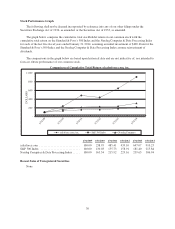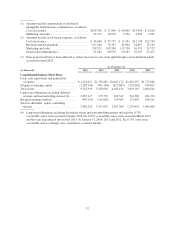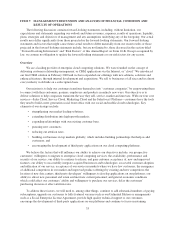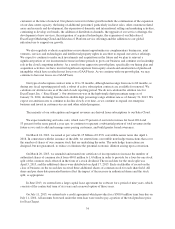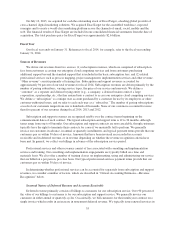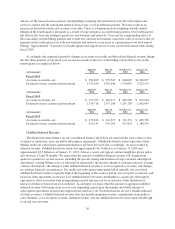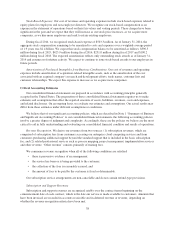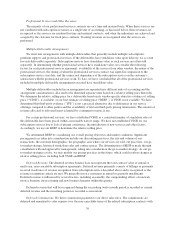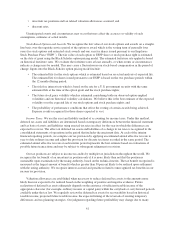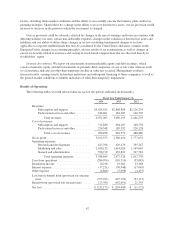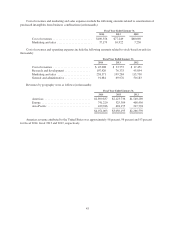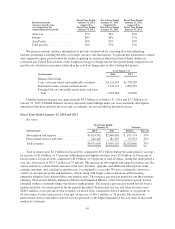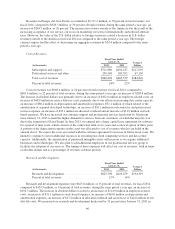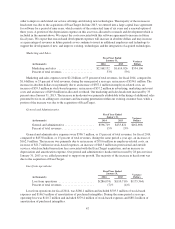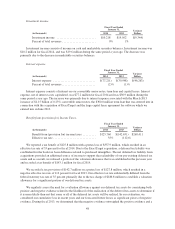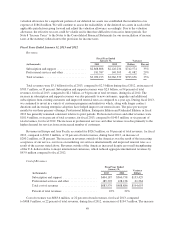Salesforce.com 2014 Annual Report Download - page 44
Download and view the complete annual report
Please find page 44 of the 2014 Salesforce.com annual report below. You can navigate through the pages in the report by either clicking on the pages listed below, or by using the keyword search tool below to find specific information within the annual report.our customers, which are typically 12 to 36 months. The commission payments, which are paid in full the month
after the customer’s service commences, are a direct and incremental cost of the revenue arrangements. The
deferred commission amounts are recoverable through the future revenue streams under the non-cancelable
customer contracts. We believe this is the preferable method of accounting as the commission charges are so
closely related to the revenue from the non-cancelable customer contracts that they should be recorded as an
asset and charged to expense over the same period that the subscription revenue is recognized.
During fiscal 2014, we deferred $265.1 million of commission expenditures and we amortized
$194.6 million to sales expense. During the same period a year ago, we deferred $232.6 million of commission
expenditures and we amortized $154.8 million to sales expense. Deferred commissions on our consolidated
balance sheets totaled $324.9 million at January 31, 2014 and $254.4 million at January 31, 2013.
Goodwill and Long-Lived Assets. We make estimates, assumptions, and judgments when valuing goodwill
and other intangible assets in connection with the initial purchase price allocation of an acquired entity, as well as
when evaluating the recoverability of our goodwill and other intangible assets on an ongoing basis. These
estimates are based upon a number of factors, including historical experience, market conditions, and information
obtained from the management of acquired companies. Critical estimates in valuing certain intangible assets
include, but are not limited to, historical and projected customer retention rates, anticipated growth in revenue
from the acquired customers and acquired technology, and the expected use of the acquired assets. These factors
are also considered in determining the useful life of acquired intangible assets. The amounts and useful lives
assigned to identified intangible assets impacts the amount and timing of future amortization expense.
The value of our goodwill and intangible assets could be impacted by future adverse changes such as, but
not limited to: a substantial decline in our market capitalization; an adverse action or assessment by a regulator;
and unanticipated competition.
We evaluate and test the recoverability of our goodwill for impairment at least annually during the fourth
quarter or more often if and when circumstances indicate that goodwill may not be recoverable. Each period we
evaluate the estimated remaining useful life of our intangible assets and whether events or changes in
circumstances warrant a revision to the remaining period of amortization. We evaluate long-lived assets, such as
property and equipment, and purchased intangible assets for impairment whenever events or changes in
circumstances indicate that the carrying amount of the assets may not be recoverable. Such events or changes in
circumstances include, but are not limited to, a significant decrease in the fair value of the underlying asset, a
significant decrease in the benefits realized from the acquired assets, difficulty and delays in integrating the
business or a significant change in the operations of the acquired assets or use of an asset. A long-lived asset is
considered impaired if its carrying amount exceeds the estimated future undiscounted cash flows the asset is
expected to generate. If a long-lived asset is considered to be impaired, the impairment to be recognized is the
amount by which the carrying amount of the asset exceeds the fair value of the asset or asset group.
Business Combinations. Accounting for business combinations requires us to make significant estimates and
assumptions, especially at the acquisition date with respect to tangible and intangible assets acquired and
liabilities assumed and pre-acquisition contingencies. We use our best estimates and assumptions to accurately
assign fair value to the tangible and intangible assets acquired and liabilities assumed at the acquisition date.
Examples of critical estimates in valuing certain of the intangible assets and goodwill we have acquired
include but are not limited to:
• future expected cash flows from subscription and support contracts, professional services contracts,
other customer contracts and acquired developed technologies and patents;
• the acquired company’s trade name, trademark and existing customer relationship, as well as
assumptions about the period of time the acquired trade name and trademark will continue to be used in
our offerings;
40


